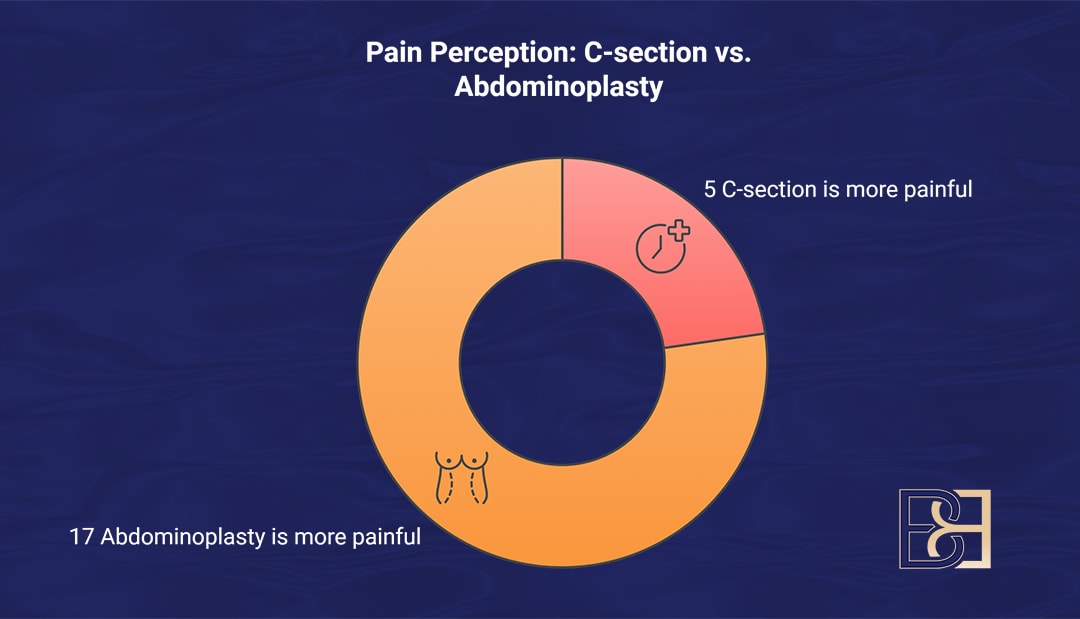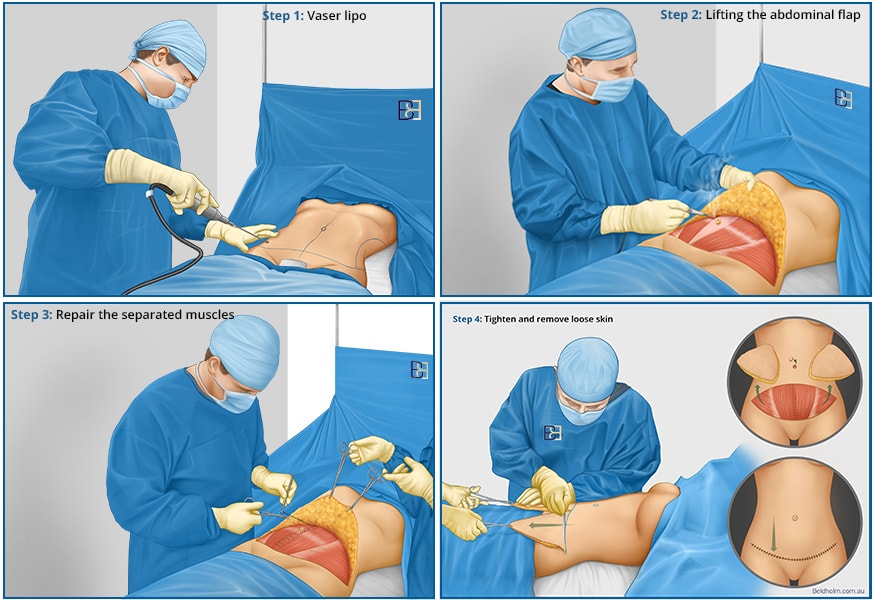Curious about whether a C-section or an abdominoplasty is more painful? You’re in the right place. While both surgical procedures come with their own levels of pain and recovery challenges, recent insights suggest that abdominoplasty might be more painful. According to a survey conducted by Dr. Beldholm, which gathered responses from 22 patients who experienced both a C-section and an abdominoplasty, 17 patients reported that the abdominoplasty was more painful, while only 5 found the C-section to be more painful. In this article, we’ll delve into the pain levels, recovery timelines, and other factors to help you understand what you might experience with each.
Key Takeaways
- Abdominoplasty is generally perceived as more painful compared to a C-section, based on patient feedback.
- C-sections involve deeper incisions and the added complexity of newborn care, contributing to a longer recovery period.
- Pain management, including medications and alternative therapies, is crucial for both procedures.
Comparing Pain Levels between a C-section and Abdominoplasty

Book your appointment online now
Dr. Beldholm meticulously analysed and categorised all patient feedback from his video “What is more painful a c-section or an abdominoplasty?” to derive some concrete statistics. Despite reviewing existing research, I found no formal studies answering this common query. This gap in formal research highlights the necessity for more in-depth studies on this topic, as understanding the pain levels associated with these surgeries can greatly influence patient care and decision-making.
While the anecdotal evidence from Dr. Beldholm’s video offers valuable insights, it also emphasises the variability in individual experiences. Factors such as personal pain threshold, health status, and psychological resilience significantly impact how one perceives and handles pain after surgery. Moreover, surgical techniques and postoperative care protocols can differ substantially among practitioners, further affecting recovery experiences.
Dr. Beldholm’s Analysis and Findings from 124 Video Comments on “What is More Painful: A C-Section or an Abdominoplasty?”
When contemplating an abdominoplasty (commonly known as a tummy tuck) after having undergone C-sections, many patients are curious about how the pain and recovery phases compare. The reality is that experiences can vary widely, largely depending on an individual’s pain tolerance and the specific details of each procedure. Nonetheless, certain recurring themes emerge when comparing these two surgeries.

An abdominoplasty, especially one with muscle repair, involves a larger incision than a C-section, and the surgery can be more extensive. Many patients describe the pain from abdominoplasty as more intense and longer-lasting, particularly because the surgery not only removes excess skin but also tightens the abdominal muscles. This can cause a more pronounced sensation of tightness and discomfort during recovery. Additionally, the recovery process for a tummy tuck (Abdominoplasty) is often outpatient, meaning you are expected to begin moving around shortly after surgery. This can feel challenging for many, especially in the first few days when the body is still healing.
Some common challenges patients report during tummy tuck (Abdominoplasty) recovery include:
- More Intensive Mobility Restrictions: You might need to sleep in a recliner for weeks and have difficulty standing straight due to swelling and muscle tightness.
- Swelling and Drains: Many patients have drains in place to help manage fluid buildup, which can be challenging. While the pain is usually managed with medications, the discomfort from drains and swelling can make mobility more difficult.
- Longer Healing Time: Unlike C-sections, which typically involve a longer hospital stay and more support, abdominoplasty recoveries often happen at home, and the recovery timeline can be longer.
C-Section Pain

While C-sections are major abdominal surgeries, many women find that the pain associated with them is less intense compared to abdominoplasty. However, this isn’t the case for everyone. The first C-section can be especially painful as it is a more invasive procedure that involves cutting through layers of tissue and muscle. Many patients report significant discomfort in the first few days, and it can take several weeks to fully recover, particularly with complications like infection or a reaction to surgical glue.
Recovery: C-Section vs. Abdominoplasty
The overall recovery process tends to be longer and more challenging with an Abdominoplasty, especially if it involves muscle repair. Some patients report being hunched over and having difficulty standing upright for weeks, whereas recovery from a C-section, although painful, can often be less challenging, particularly with subsequent surgeries.
The Verdict

In general, while both surgeries involve significant recovery time, many patients report that the abdominoplasty is more painful and has a longer recovery period compared to a C-section, especially when muscle repair is involved. However, some individuals find the pain from C-sections more intense, particularly with their first surgery. Ultimately, it depends on the individual’s body, the complexity of the procedure, and their pain tolerance.
If you’re considering abdominoplasty after multiple C-sections, it’s important to have an open conversation with your surgeon about pain management, recovery expectations, and how to best prepare for the procedure.

Understanding the Procedures
An accurate comparison of pain levels requires a clear understanding of each procedure. A C-section, or cesarean section, is often performed when a vaginal delivery poses risks to the mother or baby. An abdominoplasty, commonly known as a tummy tuck, is a procedure aimed at tightening the abdominal muscles and removing excess skin from the lower abdomen.
What is a C-Section?

A cesarean section (C-section) involves delivering a baby through an incision in the mother’s abdomen and uterus. This major surgery is often performed when labour isn’t progressing, the baby is in distress, or there are multiple births. During the procedure, seven layers of tissue, including muscle and abdominal wall layers, are cut, making it a highly invasive operation.
Women undergoing a C-section generally experience significant pain post-surgery. The recovery process involves pain management and careful wound care. The responsibilities of newborn care add complexity to the recovery period.
What is an Abdominoplasty?

An abdominoplasty is a surgical procedure that removes excess skin from the abdomen and tightens the underlying abdominal muscles. It serves both reconstructive and cosmetic purposes, offering a spectrum of techniques ranging from mini to full to extended tummy tucks.
The abdominoplasty procedure is highly adaptable to individual needs. A mini abdominoplasty targets the area below the navel and is less invasive, often resulting in a shorter recovery and reduced pain. Conversely, a full abdominoplasty of both the upper and lower abdomen, yields more comprehensive outcomes. An extended abdominoplasty goes further by including the flanks and lower back, making it ideal for patients with significant weight loss and excess skin in these regions.

During the surgery, specialist surgeons frequently perform muscle repair to correct any separation in the abdominal muscles, known as diastasis recti. This muscle repair is essential for achieving a firmer abdominal region and core strength. However, it can also lead to considerable pain during recovery as the muscles heal and adapt.
The results of an abdominoplasty are immediate, providing a flatter and more toned appearance, which many patients find rewarding despite the initial discomfort. The combination of removing excess skin and tightening the abdominal cavity not only affects aesthetics but also everyday activities.
Recovery Process and Challenges
Generally, abdominoplasty tends to be more painful than a c-section, except when undergoing a mini abdominoplasty. This is because a full or extended abdominoplasty involves more extensive surgical procedures, including the removal of excess skin and tightening of the abdominal muscles, which can lead to significant pain during recovery. The larger abdominoplasty incision and the need for muscle repair contribute to the discomfort experienced by most patients. In contrast, a mini abdominoplasty focuses on the lower abdomen and is less invasive, often resulting in less pain and a shorter recovery time.
Moreover, the pain from abdominoplasty is often described as a deep, pulling sensation due to the muscle repair, which is not typically a component of a C-section. The recovery from an abdominoplasty can also be more challenging due to the need for drains to manage fluid buildup and the requirement for patients to begin walking soon after the procedure to prevent blood clots. The use of a compression garment is crucial in reducing swelling and supporting the abdominal region, but it can add to the initial discomfort.
On the other hand, C-sections, while also considered major surgery, involve delivering a baby, which introduces additional factors like caring for a newborn immediately post-surgery. This can add to the stress and physical demands on the body, although many women report that the pain from a C-section is less intense compared to abdominoplasty. The hospital setting for C-sections typically allows for more immediate pain management and support, which can aid in a more comfortable recovery.
Ultimately, the perception of pain and recovery experience varies significantly among individuals, influenced by factors such as personal pain threshold, health status, and the specific surgical techniques used.
Factors Affecting Pain Perception

Pain perception during recovery is influenced by factors such as age, health, body weight, and the type of procedure. Individual characteristics significantly impact how pain is experienced and managed.
Understanding these factors is essential for planning effective pain management strategies, ensuring a smoother and more comfortable recovery.
Patient Health and Preexisting Conditions
A patient’s overall health and medical background significantly influence their pain perception and recovery outcomes. Individual pain tolerance levels can vary greatly, affecting post-surgery pain management. Psychological factors, such as mood disturbances, can also exacerbate pain perceptions and influence recovery.
Persistent pain after abdominoplasty may occur, with some patients experiencing long-lasting discomfort linked to nerve injury and sensory abnormalities.
Pain Tolerance and Psychological Factors
Psychological factors and pain tolerance play crucial roles in how patients experience and manage pain following surgical procedures. Older patients may report higher pain levels, suggesting that age can influence pain perception and management needs.
The relationship between psychological state and pain tolerance is important for effectively managing postoperative pain. Understanding these factors can help develop tailored pain management plans.
Dr. Beldholm’s Conclusion and Recommendations

When comparing a C-section and an abdominoplasty, it’s essential to understand that each person’s experience with pain and recovery is unique. However, as a specialist surgeon with experience in post-pregnancy and post-weight-loss body contouring, I have observed certain patterns that can help set realistic expectations.
Based on my survey, the majority of patients who have experienced both procedures find abdominoplasty to be more painful than a C-section. The larger incision, more extensive tissue manipulation, and outpatient recovery requirements contribute to the overall recovery demands for an abdominoplasty.
Book your appointment online now
Recommendations for Patients Considering an Abdominoplasty (Tummy Tuck)
For those contemplating a tummy tuck, especially after multiple C-sections, here are my top recommendations to ensure a smoother and more comfortable recovery:
- Prepare for Pain Management: Pain relief will be a crucial component of your recovery. Discuss with your surgeon all available pain management options, including medications, pain pumps, or non-medication-based therapies. Knowing your options can help you feel more in control of your pain experience.
- Plan for a Support System: Having help at home, especially during the first two weeks post-surgery, will make a significant difference. This can ease your physical strain and allow you to focus on healing.
- Commit to Mobility Gradually: Walking shortly after surgery is encouraged to prevent blood clots, but take it slow. Follow your surgeon’s guidelines on movement to avoid putting undue strain on your abdomen.
- Prepare Your Home for Recovery: Since abdominoplasty recovery requires mobility restrictions, setting up a comfortable recovery area—such as a recliner for sleeping, readily accessible restrooms, and essentials within close reach—can reduce daily discomfort.
- Have Realistic Expectations: Remember, recovery from abdominoplasty can take several weeks. Full healing, including a reduction in swelling and scar maturation, can take months. Stay patient with your body, and reach out to your surgeon with any concerns.
By understanding the differences in recovery between a C-section and an abdominoplasty and planning for these challenges, patients can make informed decisions and set themselves up for a more manageable recovery. It’s always my goal to support patients at every step of their journey, helping them achieve the results they want while minimising discomfort along the way.


